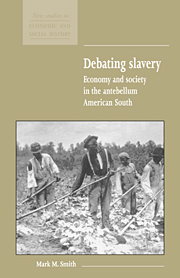Book contents
- Frontmatter
- Contents
- List of figures
- List of tables
- Preface
- 1 The contours of a debate
- 2 Slaveholders and plantations
- 3 Yeomen and non-slaveowners
- 4 Slaves
- 5 The profitability of slavery as a business
- 6 The Profitability of slavery as a system
- 7 New directions, toward consensus
- Bibliography
- Index
- Economic History Society
- New Studies in Economic and Social History
- Studies in Economic and Social History
7 - New directions, toward consensus
Published online by Cambridge University Press: 05 June 2012
- Frontmatter
- Contents
- List of figures
- List of tables
- Preface
- 1 The contours of a debate
- 2 Slaveholders and plantations
- 3 Yeomen and non-slaveowners
- 4 Slaves
- 5 The profitability of slavery as a business
- 6 The Profitability of slavery as a system
- 7 New directions, toward consensus
- Bibliography
- Index
- Economic History Society
- New Studies in Economic and Social History
- Studies in Economic and Social History
Summary
The sheer volume of work on the subject of slavery in the Old South has both delighted and exasperated experts in the field. On the one hand, we know an awful lot about virtually every aspect of slave culture, the southern economy, and planters' ideology. And recent and ongoing work promises to enlighten us still further. Thoughtful work on the nature of the slave family and black–white cultural interaction, for example, has recently been produced (Malone, 1992; Stevenson, 1996). Some of this work, which deals with relatively new subject matters such as the relationship between slave sales, slave bodies, and market pricing, is of great promise and will probably help us reconcile competing interpretations of the Old South as well as generate new ones (Johnson, 1995).
It is also clear that the intellectual gap between the principal players in the debates has narrowed. Much of the perceived distance between historians like Genovese, Oakes, and Fogel and Engerman is now, more than ever, a matter of degrees and not absolutes. By the same token, it seems clear that differences between the antebellum North and South were not as great as we have sometimes been led to believe. With respect to how historians have variously portrayed the antebellum planter class, in particular, it seems that we are in the process of an historiographical convergence. Although the camps are still often separated by their ideological and theoretical understanding of capitalism as being defined either by the existence of free wage labor or by its entrepreneurial, market orientation, both groups seem to agree on some important fundamentals.
- Type
- Chapter
- Information
- Debating SlaveryEconomy and Society in the Antebellum American South, pp. 87 - 94Publisher: Cambridge University PressPrint publication year: 1998

